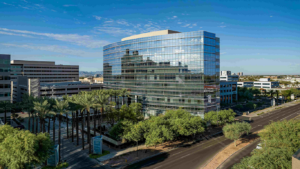As 2025 approaches, the commercial real estate (CRE) market continues to adapt to changing economic conditions, technological advancements, and shifting tenant demands. Investors, developers, and tenants are all recalibrating their strategies in response to these dynamics. This article will explore the major trends shaping the market in 2025, highlight challenges and opportunities, and offer a closer look at how one city—Philadelphia—illustrates these broader movements.
Key Trends Shaping the 2025 CRE Market
1. Hybrid Work and Office Space Demand
The hybrid work model, which became a permanent fixture after the pandemic, continues to influence demand for office spaces. Tenants are seeking smaller, more flexible workspaces, prioritizing modern amenities and sustainable building practices. Companies are focusing on collaboration hubs, while traditional office space needs are shrinking. This shift affects urban centers, where businesses are rethinking long-term leasing strategies.
2. Industrial Real Estate Remains Strong
E-commerce growth shows no signs of slowing down, boosting demand for industrial properties, particularly those close to major transportation hubs. Warehousing, last-mile distribution centers, and cold storage facilities will remain hot commodities as companies prioritize faster delivery and inventory management. Proximity to major highways and ports will be critical for industrial real estate in 2025.
3. Sustainability and ESG Initiatives
Environmental, Social, and Governance (ESG) considerations are now integral to CRE investment decisions. Buildings with sustainable designs, energy-efficient systems, and eco-friendly construction materials are more attractive to both tenants and investors. Green certifications, such as LEED (Leadership in Energy and Environmental Design), will play a pivotal role in influencing property values in 2025.
4. Shifts in Retail Spaces
The retail sector is in transition. Many brick-and-mortar stores are downsizing or closing, but experiential retail—spaces designed to offer immersive experiences rather than just products—continues to grow. Malls and shopping centers are being repurposed into mixed-use developments, combining residential, office, and entertainment spaces to create vibrant community hubs.
Philadelphia: A Microcosm of National Trends
Philadelphia’s commercial real estate market is a prime example of how cities across the U.S. are evolving. The city’s central business district and neighborhoods are adapting to national trends, while its rich history and unique urban environment present specific opportunities and challenges.
Office Space in Center City
Philadelphia’s Center City, traditionally the heart of the city’s office market, is seeing a shift in demand. Companies are downsizing their footprints on iconic streets like Market Street and JFK Boulevard. Liberty Place, once a bustling hub for corporate offices, has seen a transformation, with tenants embracing co-working spaces and flexible leases. Skyscrapers such as the Comcast Technology Center are leading the charge with high-tech, green amenities that appeal to modern companies seeking to balance employee collaboration with remote work flexibility.
Industrial Growth Along the I-95 Corridor
Philadelphia’s strategic location along the I-95 corridor makes it a key player in the industrial real estate boom. “We’re seeing an uptick in strategic real estate transactions,” shares Philadelphia real estate lawyer Oleg Sokolov. Industrial parks near the Philadelphia International Airport and along Route 291 are expanding, driven by the need for logistics and warehousing. These spaces are critical for last-mile delivery for e-commerce giants like Amazon, as well as smaller regional players. The city’s proximity to New York and Washington, D.C., makes it a prime spot for companies needing quick access to the densely populated East Coast.
Retail Redevelopment in Northern Liberties
In neighborhoods like Northern Liberties and Fishtown, retail spaces are being reimagined. Along 2nd Street and Girard Avenue, former industrial warehouses and big-box retail sites are being converted into mixed-use developments. These areas now boast trendy restaurants, boutique shops, and co-working spaces that cater to younger professionals and residents drawn to the area’s vibrant culture. This reflects the broader shift in retail toward experiential and community-focused spaces.
Challenges to Watch in 2025
Rising Interest Rates and Inflation
As of 2025, interest rates are projected to remain elevated, putting pressure on both developers and investors. Financing new projects and refinancing existing ones will be more costly, which could slow the pace of new developments. Inflation is also impacting construction costs, making it difficult for developers to keep projects within budget.
Regulatory and Zoning Changes
In urban centers like Philadelphia, regulatory changes and zoning reforms are likely to affect the CRE landscape. Cities are increasingly focusing on affordable housing, sustainability, and climate resilience, which could shift priorities for new developments. Investors will need to navigate these changes to ensure their projects align with evolving policies.
Opportunities Ahead
Adaptive Reuse Projects
One of the biggest opportunities for 2025 is the rise of adaptive reuse projects. Cities with large inventories of underutilized office and retail spaces, like Philadelphia, are seeing a surge in these projects. Converting older office buildings into residential units or mixed-use spaces offers a chance to revitalize downtown areas while meeting the demand for urban living.
Suburban Growth and Satellite Offices
As companies continue to embrace hybrid work models, suburban markets are becoming increasingly attractive. The Philadelphia suburbs, including areas like King of Prussia and Conshohocken, are experiencing growth in office demand as businesses seek smaller, decentralized locations closer to where employees live. This trend is reflected in markets across the U.S., where suburban office parks are being redeveloped to accommodate modern tenants.
A Mixed but Promising Outlook for 2025
The commercial real estate market in 2025 is a tale of both challenge and opportunity. While rising costs and changing tenant needs pose difficulties, the market is evolving to meet the demands of a more flexible, tech-driven, and sustainability-focused world. Cities like Philadelphia offer a window into the national market, where office downsizing, industrial growth, and retail transformation are reshaping urban environments. For investors, developers, and tenants, the key to success in 2025 will be adaptability and a forward-thinking approach to emerging trends.




